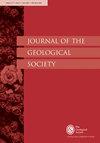华南地块早古生代韧性变形:东江南带多相剪切带
IF 3
3区 地球科学
Q2 GEOSCIENCES, MULTIDISCIPLINARY
引用次数: 0
摘要
三个平行的东西向剪切带是江南带东部多相剪切带的组成部分。这些剪切带的中观和微观构造特征以及变形温度、涡度和年代学的估计为华南地块早古生代的构造演化提供了重要信息。大多数剪切感指标(如不对称褶皱、S-C组构和旋转卟岩碎屑)显示其运动学特征为E-W右向剪切。有限应变测量显示为扁应变椭球状,具有s型和sl型构造岩。旋转刚性斑岩碎屑法和Mohr圆法得到的涡度(Wk)分别为0.58 ~ 0.80和0.66 ~ 0.89,表明该流动基本以剪切为主,单纯剪切和纯剪切的比例几乎相等。矿物变形测温仪和石英c轴织物均表明变形发生在400 ~ 550℃的中温条件下。结合我们的新时代和区域地质资料,东西向剪切带可能代表了南海早古生代造山运动末期的变形增量。本文章由计算机程序翻译,如有差异,请以英文原文为准。
Early Paleozoic ductile deformation of the South China Block: the polyphase shear zones in the Eastern Jiangnan Belt
Three parallel east–west (E–W)-trending shear zones are components of the polyphase shear zones in the eastern Jiangnan belt. The meso- and microstructural characteristics and the estimates of deformation temperatures, vorticities, and geochronology of these shear zones provide significant information regarding the tectonic evolution of the South China Block (SCB) during the early Paleozoic. Most shear sense indicators (e.g., asymmetric folds, S-C fabrics, and rotating porphyroclasts) reveal that the kinematics were characterized by E–W dextral shear. Finite strain measurements indicate an oblate strain ellipsoid shape with S-type and SL-type tectonites. The rotated rigid porphyroclasts and Mohr circle methods yield vorticity (Wk) values of 0.58–0.80 and 0.66–0.89, respectively, indicating that the flow was generally shear-dominated with almost equal proportions of simple and pure shear. Both mineral deformation thermometers and quartz c-axis fabrics indicate that the deformation occurred at medium temperature conditions of 400–550℃. Combined with our new age and regional geological data, the E–W-trending shear zones might represent an increment of deformation during the last period of the early Paleozoic orogeny in the SCB.
求助全文
通过发布文献求助,成功后即可免费获取论文全文。
去求助
来源期刊

Journal of the Geological Society
地学-地球科学综合
CiteScore
6.00
自引率
3.70%
发文量
68
审稿时长
6-12 weeks
期刊介绍:
Journal of the Geological Society (JGS) is owned and published by the Geological Society of London.
JGS publishes topical, high-quality recent research across the full range of Earth Sciences. Papers are interdisciplinary in nature and emphasize the development of an understanding of fundamental geological processes. Broad interest articles that refer to regional studies, but which extend beyond their geographical context are also welcomed.
Each year JGS presents the ‘JGS Early Career Award'' for papers published in the journal, which rewards the writing of well-written, exciting papers from early career geologists.
The journal publishes research and invited review articles, discussion papers and thematic sets.
 求助内容:
求助内容: 应助结果提醒方式:
应助结果提醒方式:


